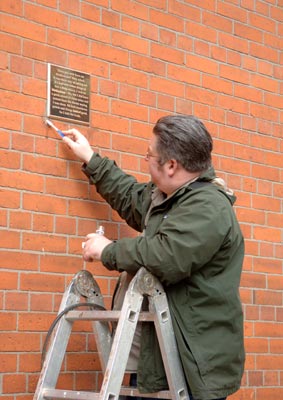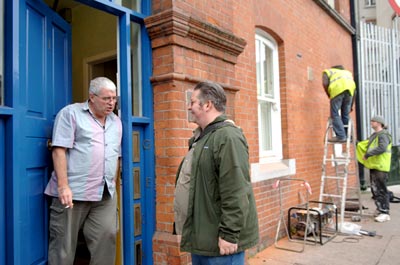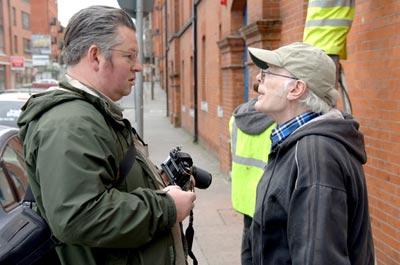Artist’s statement about the public artwork for Nicholas Street, Ross Road, Bride Street and Bride Road.

Dublin 8 and the Liberties are rich in history and heritage. Many parts of these areas are included in sightseeing tours and would be on the tourist trail. Situated between Christchurch Cathedral and Saint Patrick’s Cathedral the Victorian red brick three and four story flats on Nicholas Street, Ross Road, Bride Street and Bride Road would be positioned on such a tourist trail. These flats, which were due for demolition in the early 1990’s, were saved on the grounds that they were considered to be a part of Dublin City’s architectural heritage. These flats are social housing and though many residents left after the refurbishment in the late 1990’s some of those who remained are directly descended from the families that moved into the flats when they were originally built in 1905. Many other residents have families and connections living in the liberties for many generations. It could be argued that through social and familial continuity, lived history can be transmitted from generation to generation through stories that trace experience of events and their consequences. However the voices of these local people are generally not heard or included in the heritage of their area.
With this reality in mind Chris Reid set out to create a micro history about Nicholas Street, Ross Road, Bride Street and Bride Road. This history would be centered on audio recordings of conversations Chris had with residents and people associated with the area. This research took place between 2004 and 2008. These oral narratives formed the basis of a subjective local history and heritage that would be placed back into the area. This subjective local history would be for local, resident, and tourist alike. This history would privilege the human reality of a given situation rather than any factual account. The oral narratives recorded on minidisks were turned into a series of 220 short texts and a series of 100 longer anecdotes and stories. Each contributor participated alongside chris in the selection of a final 20 short texts for use on the plaques. These were typeset and individually cast on bronze in the form of commemorative plaques and installed on the walls of the aforementioned streets between 7 and 8 foot from the ground.

Through the composing and selection of each text, Chris, in consultation with the contributors worked to make a new heritage that attempts to open out history in a subjective and felt way. Recent memories formed the basis of some of the plaques and in some cases address issues that are important for the local residents. One plaque tells of a recovering drug addict who plans a new life for his family. In another, a man shares a joke through his first-floor window with curious bus tourists. Other plaques address hidden histories, one speaks of the influence of the Catholic Church over family planning and it’s sometimes tragic repercussions. In another a woman recounts the changed behavior and silence of return British army soldiers after World War 1 and 2. Some plaques tell of everyday actions that have since been forgotten like the cooperation by women on each floor to keep the halls clean. Other plaques map social and physical aspects of the area that have since been transformed. One plaque lists venues where a woman in the 1940’s danced and socialized all of which have since disappeared. Another briefly tells a chemical factory that burnt down to be replaced with a car park where his father worked which in turn was replaced by apartments. Altogether these plaques attempt to give historical significance to these local voices by making monuments to the ordinary, the personal and the often ephemeral experiences they describe. The texts also make links to larger municipal, national and global histories as well as working class histories and histories of childhood as well as individual histories.
One extra plaque was installed, this plaque places the project into context by briefly explaining the process’s and the dates of the work and the fact that it was commissioned through Dublin City Council’s Public Art Programme, arising from the refurbishment of these buildings and funded by the Department of the Environment, Heritage and Local Government.

The 21 one plaques comprise a permanent sculptural artwork that will over time become another part of the local heritage. The longer anecdotes and stories are in the process of being compiled into a published bookwork. This book will expand upon the narratives alluded to in the plaques and will include other narratives that originated in the audio recordings but that could not be included in the plaques. This material will be accompanied by visual material that will include photographic material from personal collections, city archives and National archives. Once again contributors will participate in the selection of the material included. This book will be available through Dublin City Council Arts Office and other venues.
Chris Reid 1.9.2009
